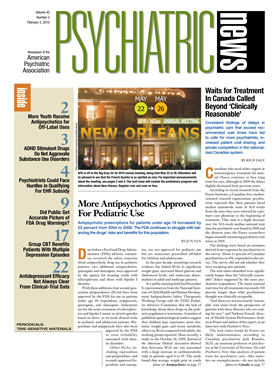Second-generation antipsychotics (SGAs) are frequently prescribed for children and adolescents for a nebulous range of indications that are not approved by the Food and Drug Administration (FDA) and not supported by research evidence.
In the Arkansas Medicaid program, the number of patients under age 18 who were put on SGAs for the first time more than doubled from 1,482 in 2001 to 3,110 in 2005, according to a study in the February Psychiatric Services. The most common diagnosis that these patients received was attention-deficit/hyperactivity disorder (ADHD), followed by depression, conduct disorder, oppositional defiant disorder, and adjustment reactions disorder.
The first SGA approved by the FDA for pediatric use was risperidone for irritability associated with autistic disorder, with approval granted in October 2006. Thus, all the SGA prescriptions for nonadult patients during the study period were for off-label use. To date, some but not all SGAs have been approved for pediatric use (see More Antipsychotics Approved for Pediatric Use), but only for the acute treatment of schizophrenia, manic or mixed episode of bipolar I disorder, or autism-related irritability.
The authors analyzed prescription and diagnosis data on patients under age 18 in the state Medicaid claims database who were first given SGA prescriptions during the period from January 2001 to December 2005. All patients included in the study had enrollment data for one year before and one year after their first SGA prescription.
Almost half (41.3 percent) of the 11,700 patients included in this analysis had no documented diagnoses that could be linked to any published clinical trial to support the SGA use for that indication, the authors found. They used a liberal criterion to assess the SGA use rationale: all diagnoses made within one year before and one year after the initial SGA prescription were taken into consideration. Another 17.5 percent of the patients had any documented diagnosis for which there was weak evidence to support SGA use.
“The increased acceptance of second-generation antipsychotics in the treatment of children during the study period was independent of a comparably robust expansion of the medical literature supporting their use,” wrote Prathamesh Pathak, M.S., B.Pharm., of the University of Arkansas for Medical Sciences, and colleagues.
Use unsupported by evidence was the most common for aripiprazole prescriptions (77.1 percent) and least common for risperidone (30.6 percent). The authors also found that having received psychotherapy and having had a previous psychiatric hospitalization were significantly associated with SGA prescriptions that were supported by evidence.
The findings echo previously reported rising trends of SGA prescriptions for young patients since the 1990s. In a review published online in Health Affairs on July 21, 2009, Stephen Crystal, Ph.D., of Rutgers University, and colleagues noted that youth from lower-income families covered by Medicaid were four times more likely than privately insured youth to be prescribed antipsychotic drugs, although the rate of antipsychotic prescriptions increased for both populations in the past decade. ADHD was the most common diagnosis in young patients given antipsychotics, and nearly all antipsychotic prescriptions were for SGAs.
